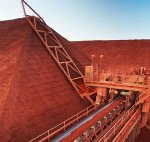4 jewels in New BHP’s crown
As BHP’s financial adviser Goldman Sachs beavers away on possible structures for the mooted spin-off company that will contain the Big Australian’s grab bag of unloved and secondary assets, AJM takes a look at the pick of the litter.
In most reckonings, the Worsley alumina refinery is the number one asset in the New BHP.

The jewel in the crown? Part of BHP Billiton’s 4.6mtpa Worsley alumina smelter in WA and a valuable part of any New BHP spin-off.
Financial firm Ord Minnett has put a net present value of almost $3.4bn on the mining and refining business, out of a combined total of $19.8bn for 15 BHP businesses up for sale.
Acquired as part of BHP’s acquisition of Billiton in 2001, Worsley was the recipient of a lavish $3bn upgrade delivered at the height of the resources boom when suppliers’ margins were at their fattest. The expansion, from 2008 to 2013, took longer and was far more expensive than planned.
Former BHP Billiton chief executive Marius Kloppers was open in admitting that expanding Worsley to 4.6mtpa capacity was one of his biggest mistakes.
In early 2013 he said to the ABC: “We spotted a technological change in aluminium and we made a great decision to not continue to invest in aluminium.
“The parallel with the alumina industry was very, very close, (but) we kept on investing. I wish we just extrapolated a bit more and had not added some of the alumina capacity that we did.”
BHP Billiton wrote down Worsley’s value by $2.13bn in 2013. Despite that the asset, consisting of the Boddington bauxite mine and alumina refinery at Collie, is a Rolls Royce business and the second largest alumina refinery in the southern hemisphere.
Should conditions in the alumina market improve, it could be a giant money-spinner.
Another prime asset in the New BHP portfolio is the company’s one third share in the Cerrejon thermal coal mine in Colombia, owned jointly with Anglo American and Glencore.
With output rising to 40mtpa and low mining costs, Cerrejon is underpinned by one of the largest coal deposits in the world, with a resource base of around five billion tonnes.
Ord Minnett puts a net present value on BHP’s investment of $2.8bn, making it the number two asset in the New BHP. Glencore and/or Anglo American would likely wish to increase their share in the project.
However, while BHP refers to Queensland Coal as one of its “four pillars”, clarity is still needed on plans for thermal coal assets which include, besides Cerrejn, mines in Australia like Mt Arthur in the Hunter valley and fledgling projects like Caroona on the Liverpool Plains.
New BHP’s third trophy is the Cannington silver and lead mine in north west Queensland, which BHP describes as “the world’s largest and lowest cost producer.”
Currently, the underground operation has an annual processing capacity of more than three million tonnes of ore. However, a major expansion of near surface resources means that BHP has the option to extend the life of the mine by more than 20 years with the staged development of an open pit, which could increase ore processing rates by 66 per cent to five million tonnes a year.
Analysts have valued the project at as much as $5bn, while Ord Minnett’s net present value, as reported in the Australian Financial Review, is a more modest $2.3bn.
The fourth highly valued asset in the New BHP’s portfolio is the Hillside aluminium smelter in South Africa, which is on target to produce around 700,000t in the financial year ending 30 June 2014.
Hillside is the healthy elder sibling to the sickly Bayside smelter which will close around June 2014 after production dropped to a paltry 95,000tpa. In contrast, Hillside is a low cost, modern smelter which BHP says is the largest in the southern hemisphere.
Ord Minnett puts a NPV of $2.8bn on Hillside.
Should aluminium prices rally, Hillside might spit out a lot of cash for New BHP’s new owners. However, at current prices, Hillside, along with Alcoa and Rio Tinto’s best smelting assets, is probably a marginal proposition.
Source from here
